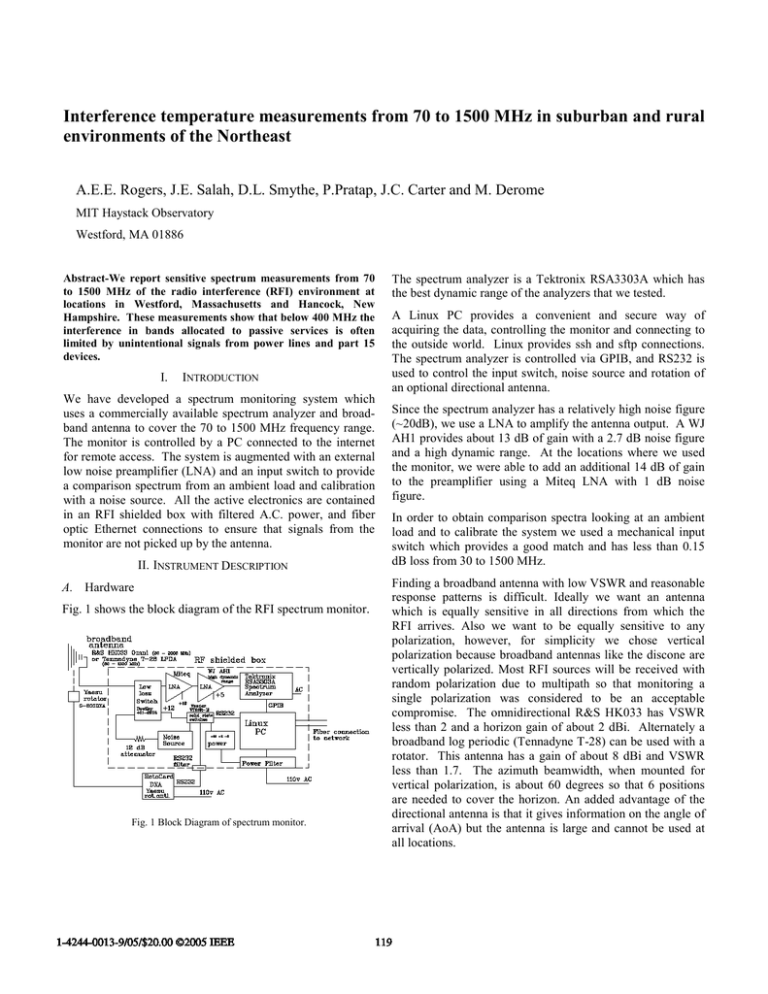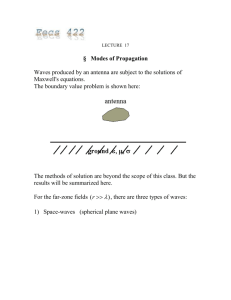Interference temperature measurements from 70 to 1500 MHz in suburban... environments of the Northeast
advertisement

Interference temperature measurements from 70 to 1500 MHz in suburban and rural environments of the Northeast A.E.E. Rogers, J.E. Salah, D.L. Smythe, P.Pratap, J.C. Carter and M. Derome MIT Haystack Observatory Westford, MA 01886 Abstract-We report sensitive spectrum measurements from 70 to 1500 MHz of the radio interference (RFI) environment at locations in Westford, Massachusetts and Hancock, New Hampshire. These measurements show that below 400 MHz the interference in bands allocated to passive services is often limited by unintentional signals from power lines and part 15 devices. I. INTRODUCTION We have developed a spectrum monitoring system which uses a commercially available spectrum analyzer and broadband antenna to cover the 70 to 1500 MHz frequency range. The monitor is controlled by a PC connected to the internet for remote access. The system is augmented with an external low noise preamplifier (LNA) and an input switch to provide a comparison spectrum from an ambient load and calibration with a noise source. All the active electronics are contained in an RFI shielded box with filtered A.C. power, and fiber optic Ethernet connections to ensure that signals from the monitor are not picked up by the antenna. II. INSTRUMENT DESCRIPTION A. Hardware Fig. 1 shows the block diagram of the RFI spectrum monitor. Fig. 1 Block Diagram of spectrum monitor. 1-4244-0013-9/05/$20.00 ©2005 IEEE The spectrum analyzer is a Tektronix RSA3303A which has the best dynamic range of the analyzers that we tested. A Linux PC provides a convenient and secure way of acquiring the data, controlling the monitor and connecting to the outside world. Linux provides ssh and sftp connections. The spectrum analyzer is controlled via GPIB, and RS232 is used to control the input switch, noise source and rotation of an optional directional antenna. Since the spectrum analyzer has a relatively high noise figure (~20dB), we use a LNA to amplify the antenna output. A WJ AH1 provides about 13 dB of gain with a 2.7 dB noise figure and a high dynamic range. At the locations where we used the monitor, we were able to add an additional 14 dB of gain to the preamplifier using a Miteq LNA with 1 dB noise figure. In order to obtain comparison spectra looking at an ambient load and to calibrate the system we used a mechanical input switch which provides a good match and has less than 0.15 dB loss from 30 to 1500 MHz. Finding a broadband antenna with low VSWR and reasonable response patterns is difficult. Ideally we want an antenna which is equally sensitive in all directions from which the RFI arrives. Also we want to be equally sensitive to any polarization, however, for simplicity we chose vertical polarization because broadband antennas like the discone are vertically polarized. Most RFI sources will be received with random polarization due to multipath so that monitoring a single polarization was considered to be an acceptable compromise. The omnidirectional R&S HK033 has VSWR less than 2 and a horizon gain of about 2 dBi. Alternately a broadband log periodic (Tennadyne T-28) can be used with a rotator. This antenna has a gain of about 8 dBi and VSWR less than 1.7. The azimuth beamwidth, when mounted for vertical polarization, is about 60 degrees so that 6 positions are needed to cover the horizon. An added advantage of the directional antenna is that it gives information on the angle of arrival (AoA) but the antenna is large and cannot be used at all locations. 119 The “isotropic interference temperature” is the antenna temperature of an isotropic antenna which has 0 dBi gain. If we define a dynamic range in dB for the second and third intermod products, DR2 and DR3, as the ratio between the maximum signal for which the intermod product would equal the calculated effective noise floor k∆TB, then B. Theoretical Performance The measured antenna temperature Tant is given by P − PL Tant = (Tcal − TL ) ant + α TL α Pon − PL where (1) Tcal = calibration temperature (K) TL = ambient load temperature (K) Pant = power on antenna DR2 = ( IIP 2 − G p − 10 log10 ( k ∆TB ) − 30 ) 2 (3) DR3 = 2 ( IIP3 − G p − 10 log10 ( k ∆TB ) − 30 ) 3 (4) Pon = power with calibration turned on where k = Boltzmann’s constant, and IIP2 and IIP3 are the input 2nd and 3rd intermod intercepts for the spectrum analyzer at zero input attenuation. α = cable loss factor The maximum input levels, m2 and m3, at these dynamic ranges are PL = power on load For 50 feet of LMR-400 cable the loss is 0.35 dB (α=0.92) at 30 MHz and increases as frequency½ to 2.5 dB at 1.5 GHz. The 1-sigma noise in the measurement of the isotropic interference temperature is given by ( ∆T = 2 10 − Ga 10 ) ( 290 ) 10 (10 × ( Bτ f s f a ) − Gp −1 2 10 Ns 10 ) − 1 + 10 Np 10 − 1 (2) where Ga = antenna gain (dBi) (2dBi for omni, 8 dBi for log periodic) Gp = preamp gain – analyzer input attenuation (dB) (21 dB for omni, 11 dB for log periodic) Ns = spectrum analyzer noise figure (dB) (~20 dB) Np = preamp noise figure (dB) (~1 dB) B = resolution (Hz) (100 kHz) fs = spectral analyzer spectral efficiency (10-5) fa = fraction of antenna time in each direction (1 for omni, 0.1 for log periodic) τ = integration time (sec) The factor of 2 arises from taking the difference between the spectrum of the antenna and the spectrum on the load. This “load switching” subtracts a noise floor baseline which then allows a much lower noise floor to be set by the incoherent integration and provides an advantage over monitors without an input switch. In one hour, the 1-sigma noise is about 10 K for either antenna using the values in parentheses. The spectral efficiency is defined as the fraction of data processed at any given frequency. Using this definition a spectrum analyzer which scans a single filter across the band would have a maximum spectral efficiency equal to the ratio of resolution to the total frequency range spanned. An ideal analyzer which continuously samples and processes the total band would have a spectral efficiency of 1. and m 2 = IIP 2 − G p − DR2 (5) m3 = IIP3 − G p − DR3 2.0 (6) For IIP2 = 14 dBm and IIP3 = -3 dBm, the achievable dynamic range is about 65 and 76 dB for IP2 and IP3 respectively and is largely independent of Gp. However the maximum signal levels to reach this dynamic range depend on Gp, and are -60 and -50 dBm for IP2 and IP3 respectively for Gp = 8 dB. Since the intermod performance of the preamp is much better than the analyzer, the input attenuator of the analyzer can be used to set Gp. In practice, a value of Gp = 11 dB, which corresponds to an analyzer input attenuation of 16 dB for a 27 dB preamp, is sufficient for the Haystack location. At quieter locations Gp can be increased to improve sensitivity. In comparing different spectrum analyzers we found it useful to measure IIP2 and IIP3 and then calculate a dynamic range from (3) and (4) using ∆ T = 290 K, B = 1 MHz and the value of Gp needed to produce a noise figure of 3 dB. We found values of DR2 from 55 to 65 dB and DR3 from 60 to 75 dB for the various models tested. The use of a preamplifier with a low noise figure not only improves the sensitivity but also, more importantly, improves accuracy since a major limit to the accuracy is set by the noise which is reflected back from the antenna due to mismatch. The noise, which is emitted from the LNA, is typically lower in an LNA with lower noise figure. The noise reflected from an antenna with reflection coefficient Γ , produces a peak to peak amplitude of ( ∆Tant ≈ Γ 290 10 Np 10 ) −1 (7) with ripple frequency period equal to the inverse of twice the antenna cable delay. This assumes that the outgoing noise from the LNA is 50% correlated with its output noise. Typical ripple amplitude is about 15 K for antenna VSWR of 1.5 : 1. 120 III. Fig. 3 shows a 24 hour spectrum vs time plot, sometimes known as a “waterfall” plot, from the Haystack site on 14 July 2005. On this day, there was a solar flare just after 11 U.T. whose spectrum can be seen extending from 200 MHz to up to 1 GHz. Also there was lightning activity later this day whose interference temperature, averaged over several minutes, was around 1000 K. MEASUREMENTS A. Average Broadband Spectra Fig. 2 shows the spectra taken at a location about 1 km from the MIT Haystack Observatory in Westford MA and at Boston University’s Sargent Camp in Hancock, New Hampshire. Both spectra show that there are clear areas of unoccupied spectrum. Fig. 3. Spectrum vs time plot from the Haystack site on 14 Jul 2005. The frequency and time resolution is this plot are 1 MHz and 10 minutes respectively. B. Study of Passive Bands Bands currently only assigned for passive use are not only useful to passive users but also provide a “clear” window to observe the noise due to unintentional radiators. Table 2 lists the radio astronomy (RA bands.) Fig. 2 Calibrated spectra from the Haystack site, and the Hancock site. The resolution is 100 kHz. The strong signal at 1295 MHz in the Haystack spectrum is from the adjacent Millstone radar, and the signals at approximately 1195 and 1395 are intermodulation products between the FM band and the radar. These spectra are an average of 24 hours. Of these bands only the 1400-1427 and 73-74.6 MHz are not shared with active users. However the 322-328.6 MHz band and portions of the other bands are clear of intentional radiators in the vicinity of the Haystack Observatory. The region of the spectrum between the picture (83.26 MHz) and the sound (87.76 MHz) carriers of channel 6 TV is also relatively clear because channel 6 is allocated to WLNE in New Bedford which is 117 km from Haystack and further away from Hancock. Table 1 lists the percentages of occupied spectrum for various levels of interference temperatures. TABLE 1 OCCUPANCY OF FREQUENCY CHANNELS Occupancy 50-1500 MHz, 100 kHz resolution Threshold (K) Haystack Hancock Correlation 350 30 26 53 400 28 23 48 450 27 20 46 3000 16 6 28 a A good test of the monitor in a clear band is to compare the measured interference temperature variation with local sidereal time [1] with a model of the sky brightness [2] convolved with the antenna beam pattern. Fig. 4 shows an example of the antenna temperature variation at Haystack and Hancock. We show the measurements at 86 MHz, rather than in the 73 to 74.6 MHz radio astronomy band because the omni antenna degrades rapidly below 80 MHz and the power line noise becomes more dominant. At the Haystack site the lower bounds of the temperature follow the expected temperature based on the sky model, but often the noise is raised by 3 dB or more. a Correlation in occupancy is the percentage of channels which exceed the temperature threshold at both sites taken over channels which exceed the threshold at either site. 121 TABLE 2 RADIO ASTRONOMY BANDS Av. Temperature (K) Frequency (MHz) Exclusively passive 37.5-38.25 73-74.6 Other Users Comments Haystack Hancock N Down on antenna response _ _ Y Power line noise 1056 3062 6 3×10 3×106 Not a RA band in USA 232 375 Strong 100 W transmitter in unprotected regions 1916 242 Partially filled with Ch 38 TV sidebands b 468 256 Clear 209 244 150.05-153 N DoD, business 322-328.6 N DoD a 406.1-410 N LMR 608-614 N TV sidebands 1400-1427 Y a b LMR = land mobile radio (Motorola Astro Smart Net) FCC only requires 60 dB attenuation of sidebands on analog TV Earlier tests with the directional antenna show the variable noise to be coming from the high voltage lines in the vicinity. At Hancock, the noise levels were dominated by local computer equipment which is located in the camp facilities within 100 m of the antenna. The antenna at the Haystack site was located at the site of the Deuterium array [3], which is more than a 100 m from any unshielded electronics. C. Sensitivity of Radio Astronomy to RFI Radio astronomy is very sensitive to RFI because the signals being observed are usually extremely weak in comparison to broadcast and communications signals. For example, the recent detection [4] of emission at 327 MHz from deuterium atoms in the interstellar gas is a signal of only about 0.5 milliKelvin. For these observations, an antenna array optimized for 327 MHz was built and extraordinary measures were taken to ameliorate the effects of RFI [3]. RFI levels detrimental to radio astronomy are given by the International Telecommunications Union (ITU) recommendation ITU-R RA.769. In the case of the deuterium array, most of the RFI was locally generated by electronics which are only required to meet the FCC part 15 specification. Sources within about 200 m of the array were located using the AoA from a RFI monitor followed by a search with a handheld receiver with a directional antenna. These sources were either shielded to reduce the RFI or replaced with an alternate device whose emissions were lower or absent in the 250 kHz band centered at 327.4 MHz and used to observe the deuterium line. Most of the signals from these unintentional radiators are harmonics of the clock oscillators. For example the 80th harmonic of the 4.092 MHz clock used in many GPS receivers results in emissions at 327.36 MHz. Fig. 5 shows spectra from the deuterium array RFI monitor taken on 12 January 2005. The strong signal close to 327.4 MHz was found to originate from a sound card plugged into a PC located in a residence about 2 km from the array. Fig. 4. Interference temperature vs local sidereal time at 86 MHz for Haystack and Hancock solid line is sky model. 122 ACKNOWLEDGEMENT az330 26.7 K p-p az300 4.6 K p-p az270 0.5 K p-p az240 1.6 K p-p az210 2.5 K p-p az180 3.2 K p-p az150 1.2 K p-p az120 0.7 K p-p az90 1.3 K p-p az60 0.9 K p-p az30 3.4 K p-p az0 44.6 K p-p 327.28 327.30 327.32 327.34 327.36 327.38 327.40 327.42 Frequency (MHz) 327.44 327.46 327.48 327.50 This work is supported by the National Science Foundation grant (ANI0338737). REFERENCES [1] A.E.E. Rogers, P. Pratap, E. Kratzenberg, M. Diaz, “Calibration of Active Antenna Arrays using a Sky Brightness Model,” RadioScience, 39, RS2023, 2004. [2] C.G.T. Haslam, C.J. Salter, H. Stoffel, W.E. Wilson, “A 408 MHz allsky Continuum Survey II- The Atlas of Contour Maps,” AA Suppl. Ser., 47, 1-143, 1982. [3] A.E.E. Rogers, P. Pratap, J. Carter, M.Diaz, “RFI Shielding and Mitigation Techniques for a Sensitive Search for the 327 MHz Line of Deuterium,” RadioScience, 40, RS5S17, 2005. [4] A.E.E. Rogers, K.A. Dudevoir, J.C. Carter, B.J. Fanous, E. Kratzenberg and T.M. Bania, “Deuterium abundance in the interstellar gas of the Galactic anticenter from the 327 MHz line”, ApJ Letters, in press, 2005. 327.52 Fig. 5. An example of the spectra from the RFI monitor of the deuterium array [3] . The 12 spectra are from Yagis pointed at the horizon and spaced every 30 degrees in azimuth. The strong signal at 327.3984 MHz is from the 29th harmonic of the 11.2896 MHz clock for the 44.1 kHz CD sampling. This RFI source was located 2 km north of the array. IV. DISCUSSION In the absence of man-made interference, the temperature should be approximately 150 K for frequencies above about 500 MHz for which the sky noise is negligible. This assumes that half the integrated antenna pattern receives the ambient temperature from the ground emission. At low frequencies, the sky noise becomes significant and half the average sky brightness at the horizon is added to the interference temperature, again assuming half the integrated antenna pattern illuminates the sky. At 327 MHz the added temperature is about 25 K. At 150, 75 and 38 MHz, the added noise is about 200, 1500, and 5,000 K respectively. The measured 327 MHz interference temperature at Haystack is consistent with natural sources, but at 74 MHz there are periods when the noise is dominated by power line emission which originates from high voltage components about 200 m from the monitor. 123


